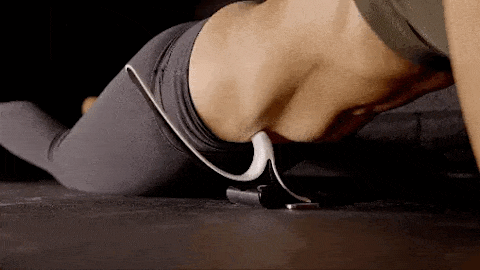I Had Back Tension For Years, But This Helped It Melt Away In 90 Seconds
I’ve been dealing with back pain and tight hips for more than a decade, and I've tried just about every solution: from Pilates classes to massage guns. While I've found a few trusty ways to ward off pain over the years, like red light, these reliable methods often come with a $500+ price tag to match.
On the hunt for a more affordable solution, I stumbled upon the Aletha The Mark®. Developed by holistic physical therapist Christine Koth, MPTh, the device doesn't attempt to ward off inflammation or boost circulation. Instead, it focuses on the root cause of aches for many people: muscle tension.
Here's why your muscle tension could be the root cause or your aches—and my firsthand experience with the Mark and how it attempts to resolve it.
What is muscle tension?
Muscle tension refers to how much your muscle is contracted at rest, and per Koth, it's the missing piece of musculoskeletal health. When a muscle is holding onto tension, it can negatively impact how your body functions.
"If a muscle is partially contracted, it only has a certain number of muscle fibers to recruit when it's time to actually use," explains Koth, who has run her own private practice for over 25 years. "Therefore, it becomes weak." This change in the mechanics of the body can cause your body to be thrown out of alignment, even causing your opposing muscles to weaken.
Unfortunately, typical activities like stretching or massage won't actually address muscle tension. While stretching increases flexibility of the muscle, it doesn't actually release tension. And while massage can temporarily increase blood flow and help release some tension, your muscles will tighten once more after the treatment.
"It's like if you take Silly Putty out of an egg and you massage it," says Koth. "It becomes stretchy, but then you put it back in the egg. Thirty seconds later, it's as hard as a rock. It doesn't actually change the way your brain is holding onto muscle tension."
Instead, Koth says reducing muscle tension is about retraining your brain. "Your brain is what's choosing to hold onto muscle tension—whether it's in your hips or your shoulders."
Your body is trying to protect itself—whether from existing pain, past trauma, or instability. For example, hypermobility can cause muscle tension as your body tries to protect itself from hypermobile joints.
So what's the solution? Koth says it takes "90 seconds of prolonged pressure" to reaffirm to your brain that your body is safe and can finally relax.
How does the Mark work
While all of your muscles can hold tension, certain muscles have a larger impact on the body. The iliacus—a key muscle in the hip flexors along with the psoas—quickly became the focus of Koth's practice.
About the size of your hand, this important muscle connects your upper body to your lower body. What's more, it was tight in nearly every person Koth saw in her practice over the last 25 years. This led to the creation of The Mark®; a tool designed to target and release tension in the deep muscle.
When I first saw The Mark®, it reminded me of a massage hook. However, it quickly took an intimidating turn when I realized the design is meant to hook around your pelvis into your hip flexors. The Mark suddenly looked a lot more like a torture device.
Designed for use on a wall or floor, The Mark® is lightweight but sturdy, with a grippy pad along the bottom to prevent slipping and sliding when in use. You simply angle align the hook with your muscle and then gently pull the handle to push the hook into your muscles for 90 seconds.
My experience with the Mark
I waited to use the Mark until I got a chance to meet with Koth over Zoom. While the website offered video instructions, I wanted her expertise on how to use the Mark correctly. It turns out, there's a pretty big margin because the iliacus muscle is so big. You simply go above your hip crease and find an area close to your pelvic bone.
While Koth recommends starting on the wall, I felt that using the hook on the floor would be the easiest for aiming close to my pelvic bone. I aligned the tool on my hardwood floors and lay on top, pulling the handle only once I felt the hook was in the right spot.
Immediately, pain shot up my leg, and it took about 30 seconds for my body to relax and leg go. Once it did, I slowly felt the tension melting away from my entire body, including my lower back.
I stayed in place for 120 seconds, slightly longer than Koth's recommendation, before doing the other side. When I stood up, I felt the release throughout my body. Needless to say, this single session with The Mark® earned the hook a permanent place in my rotation.
Now I aim to release muscle tension at least three times per week. And while the intensity of the hook still bothers me a month later, I've found my body is getting better and relaxing into the sensation the more that I use the tool.
The takeaway
While I've found plenty of trusty ways to address back pain over the years, I've ignored a root cause of the issue for far too long: muscle tension. Adding The Mark® to my routine let me start retraining my brain to let go of the muscle tension that it's carried for far too long—and I'm still shocked at how noticeably you can feel the tension melting away.


